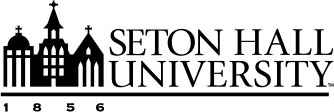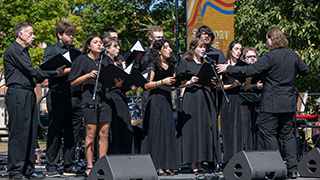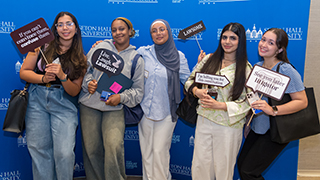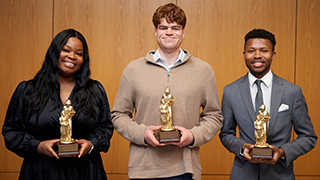The College of Arts and Sciences Goes Green
Wednesday, July 2, 2025
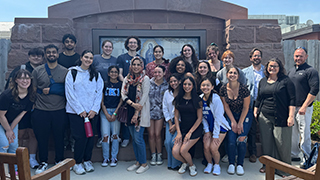
Students from Professor Khan's Core III CHEM 3551 class
A group of 20 Core III students in CHEM 3551 have turned environmental theory into
meaningful action through the Waste to Worth composting project, an innovative initiative
designed to demonstrate how academic work can address real-world sustainability challenges.
The Waste to Worth project was inspired by the principles of Green Chemistry, the
values of Laudato Si’ (Pope Francis's call for environmental stewardship), and the "Ten Green Commandments
of Laudato Si’," particularly the call to “protect the planet as our common home.” For Nada Khan, Ph.D., who taught this newly developed Core III for the first time this semester,
this project was more than a classroom exercise. It was an opportunity to teach sustainability,
build community and foster practical environmental action without overburdening already
overwhelmed students. “This was meant to relieve stress, not add to it,” Khan noted.
“I wanted students to get to know each other and collaborate on something meaningful.”
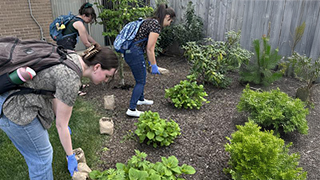
Students from Core III CHEM 3551 class dispersing compost.
The inspiration for the project came from student Aditya Kasina, who is a member of
Seton Hall’s Sustainability Committee. He shared that the committee was planning to
implement a biodigester in the campus cafeteria starting in August 2025. With this
spark, Khan tasked the class with a real challenge: designing a composting system
for campus. The students responded with enthusiasm and creativity, organizing themselves
into five groups: GINGKO, HARMONY, BLOSSOM, FROGS and SUMMIT, and working closely
with Victoria Pivovarnick co-chair of Seton Hall’s Environmental Sustainability Committee
and with Associate Vice President of Facilities and Business Affairs ground crew Jeff
Truskowski as well as faculty members Judith Stark, Snow, and Murphy.
Students took charge of the entire process: planning, documenting and assembling compost
bins. With Khan’s support, they installed three compost collection bins: two at Starbucks
locations and one near the smoothie station in the campus café. Food scraps from the
cafeteria were collected regularly by student groups, who rotated responsibilities
and maintained detailed records of their work.
The compost generated through this system did not go to waste. It was donated to Seton
Hall’s Prayer Garden, where it enriched the soil and helped support plant growth,
a full-circle effort that embodied the values of care and stewardship emphasized throughout
the course. The soil donation to the prayer garden happened on the last day of classes
for the semester. The students organized a small celebration and invited those who
had supported the project from the beginning. They were especially thrilled to see
Pivovarnick, Truskowski and Dean Farina there, watching proudly as the students spread
the nutrient-rich compost in the garden.
Beyond reducing landfill waste and promoting environmental consciousness, the project
helped students form friendships, learn teamwork, and feel a deeper connection to
the Seton Hall community. Despite being a science-based course, Core III is open to
students of all disciplines, and this diversity helped make the collaboration even
richer. “I was amazed by how professional and timely the students were,” said Khan.
“They really took ownership of the project.”
The success of Waste to Worth also depended on the support of several Seton Hall staff
and faculty, including Victoria Pivovarnick and Jeff Truskowski, whose help was essential
in getting the bins and systems in place.
What began as a classroom project quickly became a campus wide symbol of sustainable
progress and student leadership. It is a reminder that even in the face of academic
stress, young people can and will step up to protect the planet when given the tools,
support and trust to lead.
As Seton Hall continues to foster environmentally conscious initiatives, Waste to
Worth stands as a model for how academic coursework can transform not just minds,
but communities and ecosystems, one compost bin at a time. This project served as
a bridge between science, the humanities and environmental sustainability, bringing
together diverse disciplines to work toward a common goal, protecting the planet.
The compost project didn’t end there, it opened the door to a new path. Pivovarnick
connected Khan with a newly formed Sustainability Club, created by Seton Hall students
who were seeking collaboration with someone in the science department to conduct soil
amendment research on the prayer garden soil in preparation for growing herbs. As
a result, Khan’s green chemistry students are now researching soil amendment using
both compost and the prayer garden soil. If this research proves successful, Khan
plans to expand the project by offering future students the opportunity to study soil
produced from the campus biodigester, continuing the cycle of sustainability through
science and education.
Categories: Campus Life, Science and Technology
